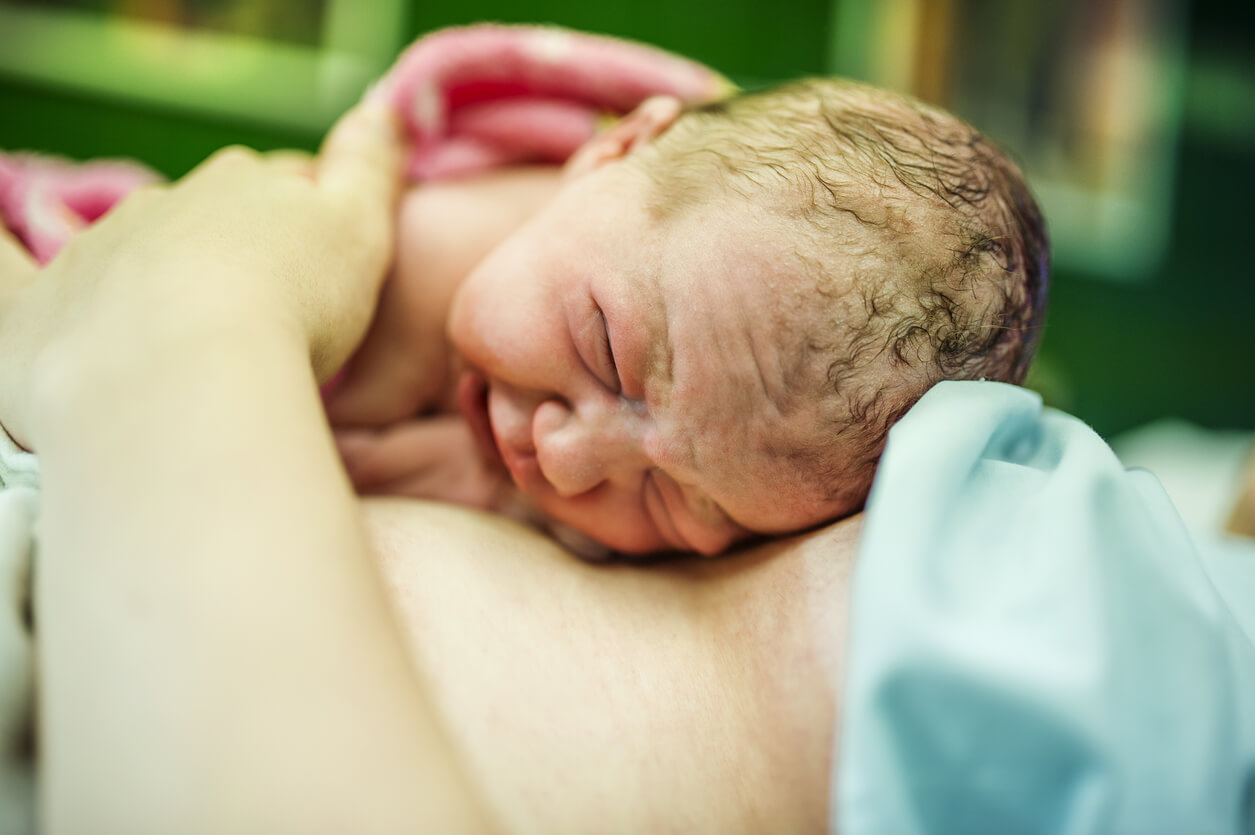Being Born at 37 Weeks Vs. Being Born at 42 Weeks

A baby is considered full-term when born after 37 weeks of gestation. However, being born at 37 weeks isn’t the same as being born at 42 weeks, as each day the baby spends in the womb better prepares it for life outside the womb.
Learn more about this topic and why it’s important to guarantee the fetus an adequate stay inside its mother’s body.
Full-term pregnancy
The criteria for defining pregnancy as having reached full term have changed considerably in recent decades. However, advances in fetal medicine have led specialists to classify these pregnancies into more specific subgroups.
For this reason, in 2013, the American College of Obstetrics and Gynecology defined 4 instances:
- Early term: includes gestations whose gestational age ranges from 37 0/7 weeks to 38 6/7 weeks.
- Full term: covers the period from 39 0/7 weeks to 40 6/7 weeks.
- Late term: used to refer to pregnancies from 41 0/7 weeks to 41 6/7 weeks.
- Post-term: defines pregnancies of 42 0/7 weeks or greater.

Every week counts
The gestational age of the baby is calculated from the date of the last menstrual period up to a given time and is quantified in weeks. At the same time, the estimate of the probable date of delivery is around 40 weeks after conception and is calculated by means of the Naegele rule.
It should be noted that only 5 out of every 100 women give birth on this specific day, but its usefulness lies in the fact that it makes it possible to assess whether the baby’s growth is in accordance with the gestational age.
Certainly, being born at 37 weeks isn’t the same as being born at 42 weeks, as this 5-week gap marks an important difference in the degree of development of the newborn.
First of all, babies who reach full term will be larger than those who don’t, as they go through a “fattening stage” from 32 weeks onward. In addition, this fat accumulation will help them to better regulate their temperature when they leave the womb.
Also, the lung maturation of full-term infants will be greater than preterm infants. In fact, babies born around 37 weeks have a higher risk of respiratory complications than those born later.
A recent study in Peru evaluated newborn morbidity and mortality at early term (before 39 weeks) and compared these data with those born after 39 weeks.
After analyzing the cases of 45 332 live births, it was concluded that the trend in births over the last 15 years was toward early term.
This phenomenon was also associated with an increased risk of low birth weight and postnatal hospital stays of more than 3 days. In general, the reasons for such hospitalizations were respiratory problems (pneumonia, hyaline membrane, transient tachypnea), lamp requirement for neonatal jaundice, congenital malformations, and neonatal mortality.

So, is being born at 37 weeks the same as being born at 42 weeks?
Definitely not. The fact that the baby stays in the womb longer can make a difference. A full-term birth, that is, between 39 and 40 weeks, is considered an ideal condition for neonatal health.
Certainly, babies born before 39 weeks can develop complications related to breathing, hearing, feeding, and temperature control. They also have a higher risk of developing infections than babies born after this date. Sometimes it’s necessary to speed up labor to avoid other life-threatening risks to the mother or fetus. It’s even possible for the baby to be born naturally between the 37th and 38th week. It’s important to keep in mind that, although babies are ready to be born at 37 weeks, not all of them will adapt in the same way.
Therefore, if you’re thinking of scheduling the birth of your baby, you should keep in mind the importance of respecting the maturation times of gestation. Waiting until 39 weeks will favor the correct development of your baby’s lungs, liver, and brain, among other vital structures. Above all, if you have a low-risk pregnancy, it’s best to wait for the birth to occur spontaneously. If possible, avoid bringing your baby’s due date forward before 39 weeks, unless the context warrants it.
A baby is considered full-term when born after 37 weeks of gestation. However, being born at 37 weeks isn’t the same as being born at 42 weeks, as each day the baby spends in the womb better prepares it for life outside the womb.
Learn more about this topic and why it’s important to guarantee the fetus an adequate stay inside its mother’s body.
Full-term pregnancy
The criteria for defining pregnancy as having reached full term have changed considerably in recent decades. However, advances in fetal medicine have led specialists to classify these pregnancies into more specific subgroups.
For this reason, in 2013, the American College of Obstetrics and Gynecology defined 4 instances:
- Early term: includes gestations whose gestational age ranges from 37 0/7 weeks to 38 6/7 weeks.
- Full term: covers the period from 39 0/7 weeks to 40 6/7 weeks.
- Late term: used to refer to pregnancies from 41 0/7 weeks to 41 6/7 weeks.
- Post-term: defines pregnancies of 42 0/7 weeks or greater.

Every week counts
The gestational age of the baby is calculated from the date of the last menstrual period up to a given time and is quantified in weeks. At the same time, the estimate of the probable date of delivery is around 40 weeks after conception and is calculated by means of the Naegele rule.
It should be noted that only 5 out of every 100 women give birth on this specific day, but its usefulness lies in the fact that it makes it possible to assess whether the baby’s growth is in accordance with the gestational age.
Certainly, being born at 37 weeks isn’t the same as being born at 42 weeks, as this 5-week gap marks an important difference in the degree of development of the newborn.
First of all, babies who reach full term will be larger than those who don’t, as they go through a “fattening stage” from 32 weeks onward. In addition, this fat accumulation will help them to better regulate their temperature when they leave the womb.
Also, the lung maturation of full-term infants will be greater than preterm infants. In fact, babies born around 37 weeks have a higher risk of respiratory complications than those born later.
A recent study in Peru evaluated newborn morbidity and mortality at early term (before 39 weeks) and compared these data with those born after 39 weeks.
After analyzing the cases of 45 332 live births, it was concluded that the trend in births over the last 15 years was toward early term.
This phenomenon was also associated with an increased risk of low birth weight and postnatal hospital stays of more than 3 days. In general, the reasons for such hospitalizations were respiratory problems (pneumonia, hyaline membrane, transient tachypnea), lamp requirement for neonatal jaundice, congenital malformations, and neonatal mortality.

So, is being born at 37 weeks the same as being born at 42 weeks?
Definitely not. The fact that the baby stays in the womb longer can make a difference. A full-term birth, that is, between 39 and 40 weeks, is considered an ideal condition for neonatal health.
Certainly, babies born before 39 weeks can develop complications related to breathing, hearing, feeding, and temperature control. They also have a higher risk of developing infections than babies born after this date. Sometimes it’s necessary to speed up labor to avoid other life-threatening risks to the mother or fetus. It’s even possible for the baby to be born naturally between the 37th and 38th week. It’s important to keep in mind that, although babies are ready to be born at 37 weeks, not all of them will adapt in the same way.
Therefore, if you’re thinking of scheduling the birth of your baby, you should keep in mind the importance of respecting the maturation times of gestation. Waiting until 39 weeks will favor the correct development of your baby’s lungs, liver, and brain, among other vital structures. Above all, if you have a low-risk pregnancy, it’s best to wait for the birth to occur spontaneously. If possible, avoid bringing your baby’s due date forward before 39 weeks, unless the context warrants it.
All cited sources were thoroughly reviewed by our team to ensure their quality, reliability, currency, and validity. The bibliography of this article was considered reliable and of academic or scientific accuracy.
- The american College of Obstetricians and Gynecologist (2017). Definition of Term Pregnancy. Recuperado de: https://www.acog.org/clinical/clinical-guidance/committee-opinion/articles/2013/11/definition-of-term-pregnancy
- Ticona, M, Huanco, D. (2017). Morbimortalidad del recién nacido a término precoz en el hospital Hipólito Unanue de Tacna durante los años 2000 a 2014. Acta médica Peruana Vol.34 N°1 Lima ene. 2017. Recuperado de: http://www.scielo.org.pe/scielo.php?script=sci_arttext&pid=S1728-59172017000100007
- Jukic, S. Et al (2013). Length of human pregnancy and contributors to its natural variation. Reproducción humana, Vol. 28 N°10, octubre de 2013, páginas 2848–2855. Recuperado de: https://academic.oup.com/humrep/article/28/10/2848/620772?login=false
This text is provided for informational purposes only and does not replace consultation with a professional. If in doubt, consult your specialist.








